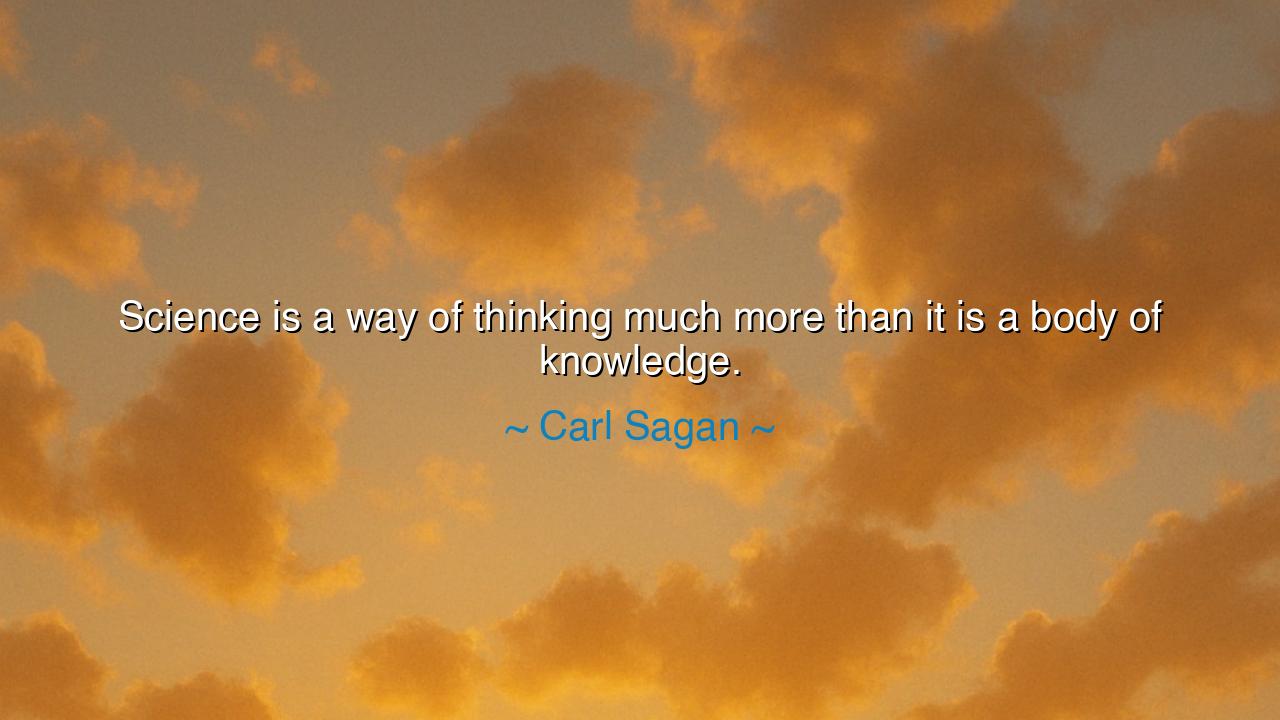
Science is a way of thinking much more than it is a body of






Hear the shining words of Carl Sagan, the great herald of the stars: “Science is a way of thinking much more than it is a body of knowledge.” In this truth lies the heart of discovery. For the scrolls of knowledge may be copied, memorized, and stored, yet without the flame of inquiry, they are but ashes. Science is not the mere gathering of facts, nor the hoarding of data—it is a spirit, a discipline of the mind, a way of looking at the universe with wonder, courage, and humility. It is a torch that burns not only in the libraries of the wise, but in the questioning soul of every seeker.
The ancients knew this long before the word “science” was spoken. When Thales gazed upon the heavens and asked what the world was made of, when Aristotle sought the causes of motion, when the sages of India pondered the cycles of creation, they were not merely reciting knowledge—they were shaping a way of thinking. They sought patterns where others saw chaos, they asked questions where others only accepted fate. Thus, science is born not from possession, but from pursuit, not from what is held, but from how one dares to seek.
Consider the tale of Galileo Galilei. The knowledge of his day declared that the Earth was fixed, unmoving at the center of all things. Yet Galileo lifted his telescope to the night sky and saw moons circling Jupiter. This was not simply the acquisition of new facts—it was a triumph of thinking differently, of questioning authority, of daring to test what others only believed. His discovery was more than a body of knowledge; it was a revolution of the mind, a torch lit against the darkness of unexamined tradition.
So too did the Wright brothers embody this truth. They were not scholars of vast libraries, nor custodians of endless facts. But they carried within them a way of thinking—to test, to fail, to try again, to let the wind itself be their teacher. It was this way of thinking, not a stockpile of knowledge, that gave birth to flight. And in their fragile plane upon the sands of Kitty Hawk, humanity rose on wings of thought before it rose on wings of wood and cloth.
The message is clear: science is alive only in the mind that questions. A thousand books may teach the discoveries of others, but if they do not awaken in you the hunger to ask, the courage to doubt, and the humility to be corrected, then they remain lifeless words. But if even a single spark of true inquiry lives within you, then you walk the path of science, no matter how small your store of facts may be.
The lesson for us, then, is not to worship knowledge as a static treasure, but to practice thinking as a living art. Ask questions each day. Seek patterns in the world around you. Do not be content with what is handed down, but test, reflect, and explore. When you hear a claim, do not ask only if it is true—ask how it is known to be true. In this way, you will live as a scientist of the spirit, not because of what you own in memory, but because of how you see.
What must you do? Cultivate curiosity. Rejoice in wonder. Practice doubt, not to destroy truth, but to strengthen it. Read and learn, yes, but above all, train the mind to ask, Why? How? What if? Let your thoughts be experiments, your life a laboratory of discovery. For in the end, it is not the body of knowledge that grants us wisdom, but the way of thinking that turns knowledge into light.
Therefore, remember Sagan’s words. “Science is a way of thinking much more than it is a body of knowledge.” Let this truth guide your path. Do not merely collect truths like stones—polish them, turn them, and use them to build bridges across the abyss of ignorance. For the spirit of science is not in what is known, but in the endless journey of the mind that seeks to know. And in that journey, humanity rises, generation after generation, toward the stars.






AAdministratorAdministrator
Welcome, honored guests. Please leave a comment, we will respond soon